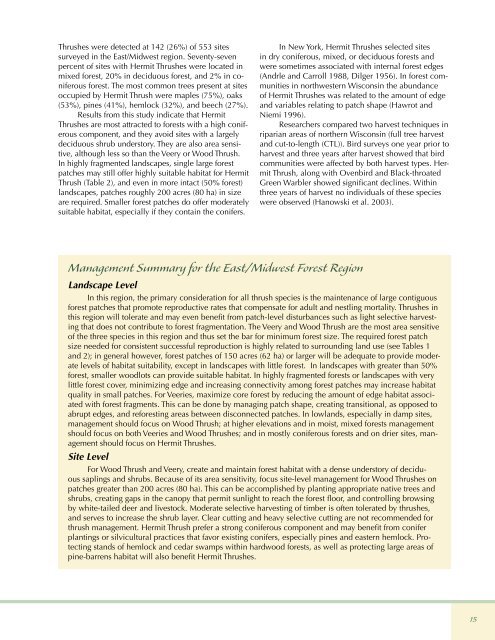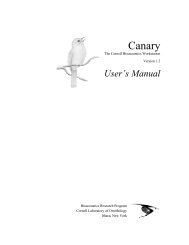A Land Manager's Guide to Improving Habitat for Forest Thrushes
A Land Manager's Guide to Improving Habitat for Forest Thrushes
A Land Manager's Guide to Improving Habitat for Forest Thrushes
Create successful ePaper yourself
Turn your PDF publications into a flip-book with our unique Google optimized e-Paper software.
<strong>Thrushes</strong> were detected at 142 (26%) of 553 sites<br />
surveyed in the East/Midwest region. Seventy-seven<br />
percent of sites with Hermit <strong>Thrushes</strong> were located in<br />
mixed <strong>for</strong>est, 20% in deciduous <strong>for</strong>est, and 2% in coniferous<br />
<strong>for</strong>est. The most common trees present at sites<br />
occupied by Hermit Thrush were maples (75%), oaks<br />
(53%), pines (41%), hemlock (32%), and beech (27%).<br />
Results from this study indicate that Hermit<br />
<strong>Thrushes</strong> are most attracted <strong>to</strong> <strong>for</strong>ests with a high coniferous<br />
component, and they avoid sites with a largely<br />
deciduous shrub unders<strong>to</strong>ry. They are also area sensitive,<br />
although less so than the Veery or Wood Thrush.<br />
In highly fragmented landscapes, single large <strong>for</strong>est<br />
patches may still offer highly suitable habitat <strong>for</strong> Hermit<br />
Thrush (Table 2), and even in more intact (50% <strong>for</strong>est)<br />
landscapes, patches roughly 200 acres (80 ha) in size<br />
are required. Smaller <strong>for</strong>est patches do offer moderately<br />
suitable habitat, especially if they contain the conifers.<br />
In New York, Hermit <strong>Thrushes</strong> selected sites<br />
in dry coniferous, mixed, or deciduous <strong>for</strong>ests and<br />
were sometimes associated with internal <strong>for</strong>est edges<br />
(Andrle and Carroll 1988, Dilger 1956). In <strong>for</strong>est communities<br />
in northwestern Wisconsin the abundance<br />
of Hermit <strong>Thrushes</strong> was related <strong>to</strong> the amount of edge<br />
and variables relating <strong>to</strong> patch shape (Hawrot and<br />
Niemi 1996).<br />
Researchers compared two harvest techniques in<br />
riparian areas of northern Wisconsin (full tree harvest<br />
and cut-<strong>to</strong>-length (CTL)). Bird surveys one year prior <strong>to</strong><br />
harvest and three years after harvest showed that bird<br />
communities were affected by both harvest types. Hermit<br />
Thrush, along with Ovenbird and Black-throated<br />
Green Warbler showed significant declines. Within<br />
three years of harvest no individuals of these species<br />
were observed (Hanowski et al. 2003).<br />
Management Summary <strong>for</strong> the East/Midwest <strong>Forest</strong> Region<br />
<strong>Land</strong>scape Level<br />
In this region, the primary consideration <strong>for</strong> all thrush species is the maintenance of large contiguous<br />
<strong>for</strong>est patches that promote reproductive rates that compensate <strong>for</strong> adult and nestling mortality. <strong>Thrushes</strong> in<br />
this region will <strong>to</strong>lerate and may even benefit from patch-level disturbances such as light selective harvesting<br />
that does not contribute <strong>to</strong> <strong>for</strong>est fragmentation. The Veery and Wood Thrush are the most area sensitive<br />
of the three species in this region and thus set the bar <strong>for</strong> minimum <strong>for</strong>est size. The required <strong>for</strong>est patch<br />
size needed <strong>for</strong> consistent successful reproduction is highly related <strong>to</strong> surrounding land use (see Tables 1<br />
and 2); in general however, <strong>for</strong>est patches of 150 acres (62 ha) or larger will be adequate <strong>to</strong> provide moderate<br />
levels of habitat suitability, except in landscapes with little <strong>for</strong>est. In landscapes with greater than 50%<br />
<strong>for</strong>est, smaller woodlots can provide suitable habitat. In highly fragmented <strong>for</strong>ests or landscapes with very<br />
little <strong>for</strong>est cover, minimizing edge and increasing connectivity among <strong>for</strong>est patches may increase habitat<br />
quality in small patches. For Veeries, maximize core <strong>for</strong>est by reducing the amount of edge habitat associated<br />
with <strong>for</strong>est fragments. This can be done by managing patch shape, creating transitional, as opposed <strong>to</strong><br />
abrupt edges, and re<strong>for</strong>esting areas between disconnected patches. In lowlands, especially in damp sites,<br />
management should focus on Wood Thrush; at higher elevations and in moist, mixed <strong>for</strong>ests management<br />
should focus on both Veeries and Wood <strong>Thrushes</strong>; and in mostly coniferous <strong>for</strong>ests and on drier sites, management<br />
should focus on Hermit <strong>Thrushes</strong>.<br />
Site Level<br />
For Wood Thrush and Veery, create and maintain <strong>for</strong>est habitat with a dense unders<strong>to</strong>ry of deciduous<br />
saplings and shrubs. Because of its area sensitivity, focus site-level management <strong>for</strong> Wood <strong>Thrushes</strong> on<br />
patches greater than 200 acres (80 ha). This can be accomplished by planting appropriate native trees and<br />
shrubs, creating gaps in the canopy that permit sunlight <strong>to</strong> reach the <strong>for</strong>est floor, and controlling browsing<br />
by white-tailed deer and lives<strong>to</strong>ck. Moderate selective harvesting of timber is often <strong>to</strong>lerated by thrushes,<br />
and serves <strong>to</strong> increase the shrub layer. Clear cutting and heavy selective cutting are not recommended <strong>for</strong><br />
thrush management. Hermit Thrush prefer a strong coniferous component and may benefit from conifer<br />
plantings or silvicultural practices that favor existing conifers, especially pines and eastern hemlock. Protecting<br />
stands of hemlock and cedar swamps within hardwood <strong>for</strong>ests, as well as protecting large areas of<br />
pine-barrens habitat will also benefit Hermit <strong>Thrushes</strong>.<br />
15

















